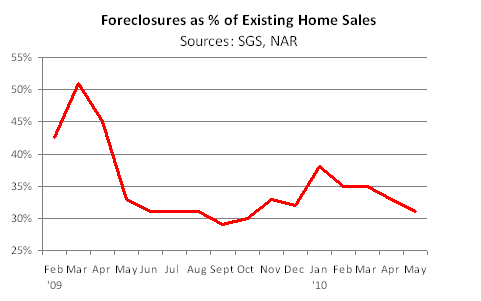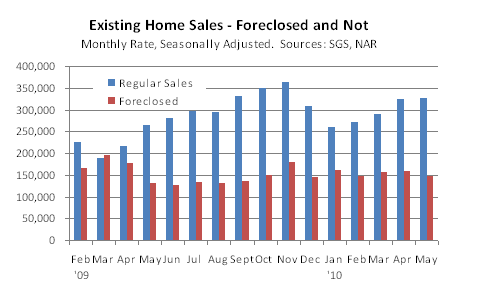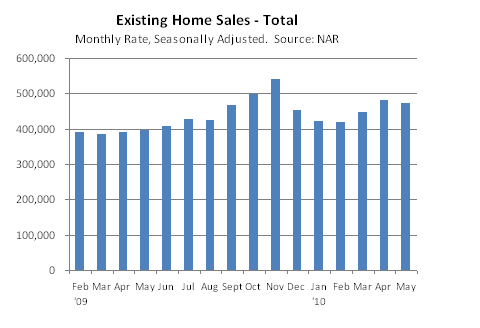No. 304: Census Jobs Loss, Home Sales
JOHN WILLIAMS’ SHADOW GOVERNMENT STATISTICS
COMMENTARY NUMBER 304
Census Jobs Loss, Home Sales
June 23, 2010
__________
Census Firings Cost June Payrolls Roughly 240,000 Jobs
May New Home Sales Down 40.5% in Month
After Major Downside Revisions to Earlier Reporting
__________
PLEASE NOTE: The next regular Commentary is scheduled for Friday, June 25th, following the release of the third estimate (second revision) of first-quarter 2010 GDP, and will include an assessment of the May new orders for durable goods due for release tomorrow (Thursday, June 24th).
– Best wishes to all, John Williams
What appears to be happening in the sudden "unexpected" weakening of a number of business statistics is a combination of reporting catch-up and a re-intensification of the economic downturn. This area will be covered more deeply in a broader update of economic activity in this Friday’s upcoming Commentary No. 305.
Forget the private sector payroll change that will get the press headlines, the total payroll change net of census firings is the number to watch. It includes the private sector as well as other government payrolls, a sector that has been seeing downside pressure recently, particularly at the state and local levels.
I would look for an outright contraction of June payrolls, net of temporary census impact. Such would mean an aggregate monthly loss in excess of 250,000 jobs. The early consensus from Briefing.com is an aggregate loss of 70,000 jobs in June, versus May’s census-spiked gain of 431,000, with the June U.3 unemployment rate unchanged at 9.7%. I would be surprised if the consensus estimates do not turn more negative.
As to unemployment, an increase from both census catch-up and underlying economic weakness could push the U.3 unemployment rate to 10% or higher.
Looking ahead, there still are 330,737 temporary census hires who will lose their jobs in the next couple of months, depressing reported payroll change in July and August, etc.
On a similar basis, today’s May new home sales (counted based on contract signings, Census Bureau) tumbled much more than expected, down by a statistically-significant 32.7% (40.5% net of prior period revisions) +/- 11.6% (95% confidence interval). The record low-level of an annualized 300,000 unit May sales pace was down from 446,000 in April, but April’s level was revised downward from 504,000, and March’s new level of 389,000 was revised downward from the benchmark revision level of 439,000.
Beyond the highly unstable nature of recent housing reports (see also the housing starts assessment in Commentary No. 303, the pattern — as the boosts from short-term stimulus measures pass — is that the "rebound" in these numbers was not as great as previously advertised, and weaker-than-expected economic activity again is taking hold.
Foreclosure activity also remains a major distortion in these numbers, with NAR estimating 31% of new home sales for May in the "distressed" category (the April estimate was 33%, but the number of foreclosures still has been fairly steady). That percentage should jump sharply in the next couple of months, as overall sales activity slows further. Census acknowledges that a portion of new home sales is from foreclosure activity but offers no estimates. Purportedly, foreclosure activity is on the rise, and some in the construction trade have difficulty competing with the pricing of foreclosed properties. Until the foreclosure problem works itself out, monthly changes in these numbers cannot be taken as meaningful indicators of trends in underlying activity in homeowner real estate, as it relates to general economic activity.
The following updated graphs reflect different measures of home sales activity since February 2009. The numbers, through May 2010, reflect the seasonally-adjusted level of monthly sales, rather than the annual rate usually published.




New Orders for Durable Goods (May 2010). May durable goods orders are due for release tomorrow, Thursday, June 24th. The recent benchmark revisions appear to have put an upside recovery-bias into the monthly reporting. Nonetheless, the series should remain randomly volatile, with softer monthly numbers seen over time. Briefing.com shows a consensus forecast of a monthly contraction of 1.4% for May, versus the 2.8% gain reported initially for April.
Gross Domestic Product — GDP (First-Quarter 2010 — Third Estimate). The second revision to the first-quarter 2010 GDP estimate is due for release on Friday, June 25th. Likely to hold near the prior estimate of 3.0% annualized real growth, any GDP revision more than statistical noise would be surprise at this point in the reporting cycle.
__________